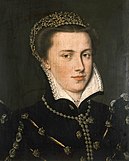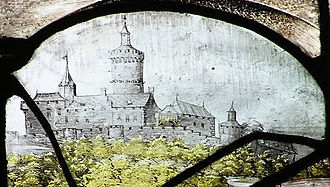The Siege of Godesberg
pronunciation
The Siege of Godesberg, 18 November – 17 December 1583, was the first major siege of the Cologne War (1583–1589). Seeking to wrest control of an important fortification, Bavarian and mercenary soldiers surrounded the Godesberg, and the village then of the same name, now Bad Godesberg, located at its foot. On top of the mountain sat a formidable fortress, similarly named Godesburg, built in the early 13th century during a contest over the election of two competing archbishops.
Towering over the Rhine valley, the Godesburg's strategic position commanded the roads leading to and from Bonn, the Elector of Cologne's capital city, and Cologne, the region's economic powerhouse. Over time, the Electors strengthened its walls and heightened its towers. They added a small residence in the 14th century and the donjon (also called a Bergfried or keep) developed as a stronghold of the Electoral archives and valuables. By the mid-16th century, the Godesburg was considered nearly impregnable and had become a symbol of the dual power of the Prince-electors and Archbishops of Cologne, one of the wealthiest ecclesiastical territories in the Holy Roman Empire. The Cologne War, a feud between the Protestant Elector, Gebhard, Truchsess of Waldburg, and the Catholic Elector, Ernst of Bavaria, was yet another schismatic episode in the Electoral and archdiocesan history.
The Godesburg came under attack from Bavarian forces in November 1583. It resisted a lengthy cannonade by the attacking army; finally, sappers tunneled into the basalt core of the mountain, placed 680 kilograms (1,500 lb) of powder into the tunnel and blew up a significant part of the fortifications. The explosion killed many of the defending troops, but the resulting rubble impeded the attackers' progress, and the remaining defenders continued to offer staunch resistance. Only when some of the attackers entered the castle's inner courtyard through the latrine system were the Bavarians able to overcome their opponents. The Godesburg's commander and some surviving defenders took refuge in the keep; using prisoners held in the dungeons as hostages, the commander negotiated safe passage for himself, his wife and his lieutenant. The others who were left in the keep—men, women and children—were killed. Nearby Bonn fell to the Bavarians the following month.
Background
The Cologne War, 1583–1589, was triggered by the 1582 conversion of the Archbishop-Prince Elector of Cologne, Gebhard, Truchsess of Waldburg, to Calvinism, and his subsequent marriage to Agnes of Mansfeld-Eisleben in 1583. When he refused to relinquish the Electorate, a faction of clerics in the Cologne Cathedral chapter elected another archbishop, Ernst of Bavaria, of the House of Wittelsbach.[4] Initially, troops of the competing Archbishops of Cologne fought for control of the Electorate; within a few months, the local feud between the two parties expanded to include supporters from the Electorate of the Palatinate on the Protestant side, and the Duchy of Bavaria on the Catholic side. Italian mercenaries hired with papal gold augmented the Catholic force. In 1586, the conflict expanded further, with direct involvement of the Spanish Netherlands for the Catholic side, and tertiary involvement from Henry III of France and Elizabeth I of England on the Protestant side.[5] At its most fundamental, it was a local feud between two competing dynastic interests—the Seneschals (Truchsess) of the House of Waldburg and the dukes of the House of Wittelsbach—that acquired religious overtones. The dispute had broad implications in the political, social, and dynastic balance of the Holy Roman Empire. It tested the principle of ecclesiastical reservation established in the religious Peace of Augsburg (1555). The 1555 agreement settled religious problems in the Empire with the principle Cuius regio, eius religio: the subjects of a secular prince followed the religion of their sovereign. Ecclesiastical reservation excluded the territories of the imperial prelates (bishops, archbishops, abbots or abbesses) from cuius regio, eius religio. In an ecclesiastical territory, if the prelate changed his religion, his subjects did not have to do so. Instead, the prelate was expected to resign from his post. Problematically, the 1555 agreement did not specify this detail.[5]
Controversy of conversion
Agnes of Mansfeld-Eisleben was a Protestant canoness (meaning that she was a woman living in a religious community, but not bound by a perpetual vow) at a convent in Gerresheim, today a district of Düsseldorf. After 1579, she maintained a lengthy liaison with the Archbishop of Cologne, Gebhard of Waldburg-Trauchburg, Truchsess of Waldburg. In defense of her honor, two of her brothers convinced Gebhard to marry her, and Gebhard considered converting to Calvinism for her.[6] Rumors spread throughout the Electorate of his possible conversion, and that he might refuse to relinquish his position. The Electorate had overcome similar problems. Hermann of Wied had converted to Protestantism and resigned in 1547. Salentin of Isenburg-Grenzau, Gebhard's immediate predecessor, had resigned upon his marriage. In December 1582, Gebhard announced his conversion and extended equal religious rights to Protestants in the Electorate. In February, he married Agnes. At the end of March 1583, the Pope excommunicated him. The Cathedral chapter promptly elected a new archbishop, Ernst of Bavaria.[7] With two competing archbishops, both claiming the see and the Electorate, the contenders and their supporters gathered the troops. In numbers, Ernst had the advantage. The Pope hired 5,000 mercenaries from the Farnese family to support the new Elector.[7] Ernst's brother, the Duke of Bavaria, provided an army and Ernst arranged for his brother Ferdinand's army to take possession of the so-called Oberstift, the southern territory of the Electorate; his troops plundered many of its villages and towns.[8] With the support of Adolf von Neuenahr and the Count Solms, Gebhard secured some of the northern and eastern portions of the Electorate, where he held a geographical advantage in his proximity to the rebellious Dutch provinces. In the south, however, Ferdinand's troops hunted the soldiers Gebhard had left in possession of such Oberstift villages as Ahrweiler and Linz; Gebhard's troops were forced out of their strongholds, hunted through the countryside, and eventually captured. By the fall of 1583, most of the Oberstift had fallen to Ferdinand's army and many of Gebhard's erstwhile supporters—including his own brother—had returned home. In some cases, they honored parole agreements made after their capture. A strong supporter, Johann Casimir of Simmern, brother of the powerful Louis VI, Elector Palatine, returned to the Palatine when his brother died. Other supporters were frustrated by Gebhard's chronic inability to pay his troops, or intimidated by threats of Rudolf II, Holy Roman Emperor. By late October 1583, most of the Oberstift had fallen, although he still held the Godesburg, located near the villages of Godesberg and Friesdorf, the formidable fortress at Bonn, and the fortified village of Poppelsdorf.[8]
The Siege of Godesberg Paintings and Images




